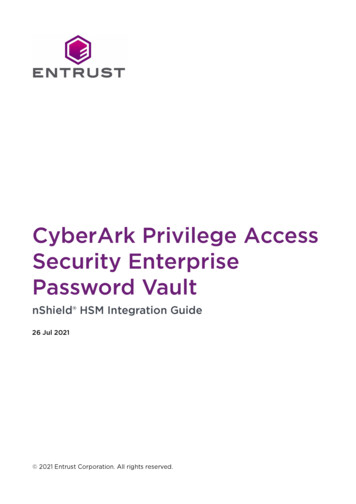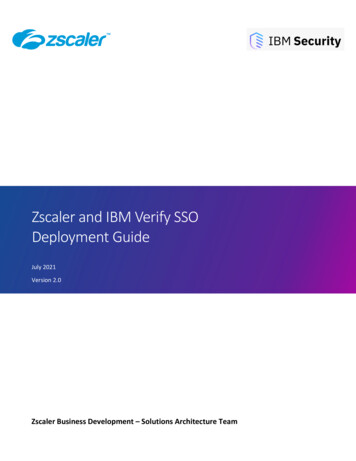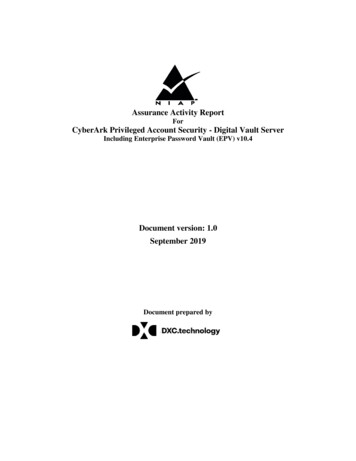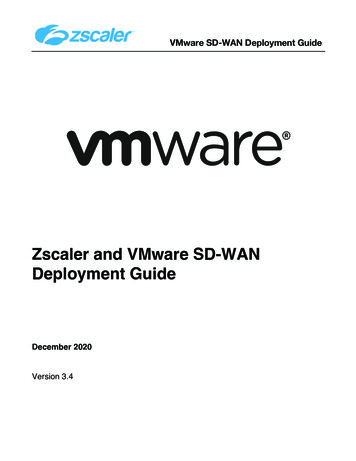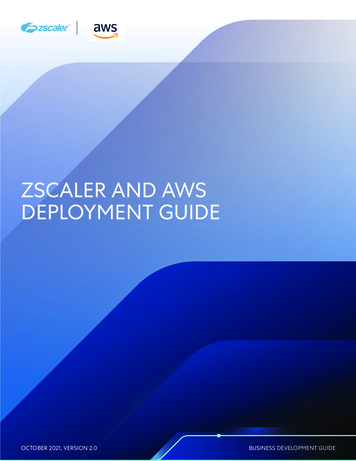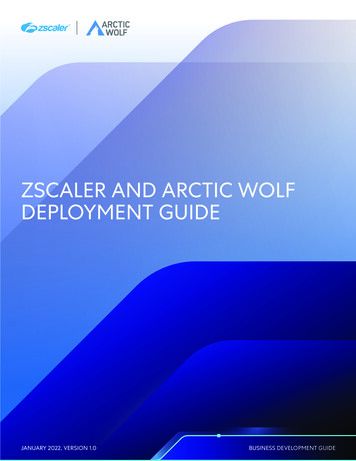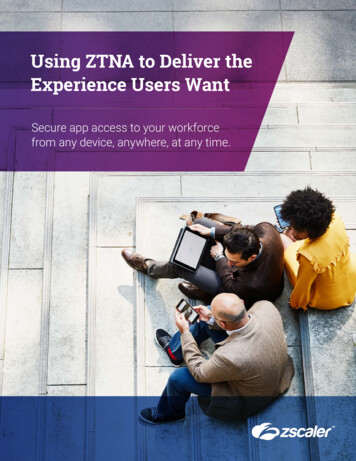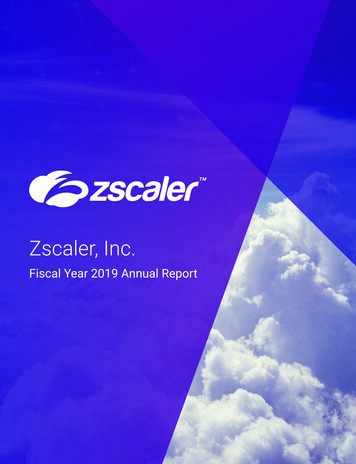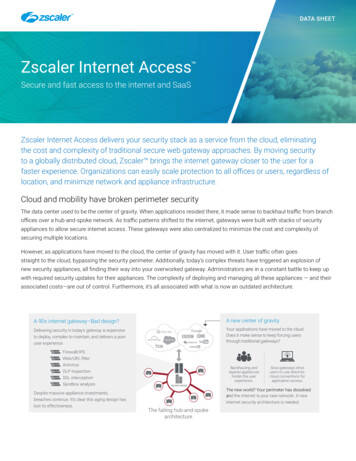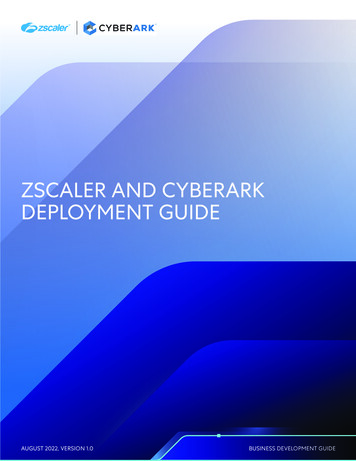
Transcription
ZSCALER AND CYBERARKDEPLOYMENT GUIDEAUGUST 2022, VERSION 1.0BUSINESS DEVELOPMENT GUIDE
ZSCALER AND CYBERARK DEPLOYMENT GUIDEContentsTerms and Acronyms4About This Document5Zscaler Overview5CyberArk Overview5Audience5Software Versions5Request for Comments5Zscaler and CyberArk Introduction6ZIA Overview6ZPA Overview6Zscaler Resources6CyberArk Access Management Overview7CyberArk Resources7Zscaler SAML Single Sign-On (SSO)8Zscaler Requirements for SSO8Zscaler SAML Properties8Configure Zscaler in the CyberArk Admin Portal (Part 1)9Configure Zscaler on the Zscaler Portal11Enable SAML Auto Provisioning13Enable SAML14 2022 Zscaler, Inc. All rights reserved.2
ZSCALER AND CYBERARK DEPLOYMENT GUIDEProvision Accounts with SCIM15Enable SCIM Provisioning for Your App in the Admin Portal15Verify Users to Synchronize18Enable SCIM Synchronization20Provision Users with Custom Attributes with SCIMAppendix A: Requesting Zscaler SupportGather Support Information212323Save Company ID 23Enter Support Section24 2022 Zscaler, Inc. All rights reserved.3
ZSCALER AND CYBERARK DEPLOYMENT GUIDETerms and AcronymsThe following terms and acronyms are used in this ZPADefinitionCentral Authority (Zscaler)Comma-Separated ValuesDead Peer Detection (RFC 3706)Generic Routing Encapsulation (RFC2890)Internet Key Exchange (RFC2409)Internet Protocol Security (RFC2411)Perfect Forward SecrecyPre-Share KeySecure Socket Layer (RFC6101)X-Forwarded-For (RFC7239)Zscaler Internet AccessZscaler Private Access 2022 Zscaler, Inc. All rights reserved.4
ZSCALER AND CYBERARK DEPLOYMENT GUIDEAbout This DocumentThis section describes the organizations and requirements for the integration covered in this deployment guide.Zscaler OverviewZscaler (NASDAQ: ZS) enables the world’s leading organizations to securely transform their networks and applications fora mobile and cloud-first world. Zscaler Internet Access (ZIA) and Zscaler Private Access (ZPA) services create fast, secureconnections between users and applications, regardless of device, location, or network. Zscaler delivers its services 100%in the cloud and offers the simplicity, enhanced security, and improved user experience that traditional appliances orhybrid solutions can’t match. Used in more than 185 countries, Zscaler operates a massive, global cloud security platformthat protects thousands of enterprises and government agencies from cyberattacks and data loss. For more information,go to Zscaler’s website or follow Zscaler on Twitter @zscaler.CyberArk OverviewCyberArk (NASDAQ: CYBR) is the global leader in Identity Security. Centered on privileged access management,CyberArk provides comprehensive security offerings for any identity – human or machine – across business applications,distributed workforces, hybrid cloud workloads and throughout the DevOps lifecycle. The world’s leading organizationstrust CyberArk to help secure their most critical assets. To learn more go to CyberArk’s website, read the CyberArk blogs.or follow on Twitter via @CyberArk, LinkedIn, or Facebook.AudienceThis guide is for network administrators, endpoint and IT administrators, and security analysts responsible for deploying,monitoring, and managing enterprise security systems. For additional product and company resources, refer to: Zscaler Resources CyberArk Resources Appendix A: Requesting Zscaler SupportSoftware VersionsThis document was authored using the latest version of the Zscaler software.Request for Comments For prospects and customers: we value reader opinions and experiences. Contact us at partner-doc-support@zscaler.com to offer feedback or corrections for this guide. For Zscaler employees: contact z-bd-sa@zscaler.com to reach the team that validated and authored the integrationsin this document. 2022 Zscaler, Inc. All rights reserved.5
ZSCALER AND CYBERARK DEPLOYMENT GUIDEZscaler and CyberArk IntroductionBelow are overviews of the Zscaler and CyberArk applications described in this deployment guide.ZIA OverviewZIA is a secure Internet and web gateway delivered as a service from the cloud. Think of it as a secure Internet onramp—all you do is make Zscaler your next hop to the Internet via one of the following methods: Setting up a tunnel (GRE or IPSec) to the closest Zscaler data center (for offices). Forwarding traffic via our lightweight Zscaler Client Connector or PAC file (for mobile employees).No matter where users connect—a coffee shop in Milan, a hotel in Hong Kong, or a VDI instance in South Korea—they getidentical protection. ZIA sits between your users and the Internet and inspects every transaction inline across multiplesecurity techniques (even within SSL).You get full protection from web and Internet threats. The Zscaler cloud platform supports Cloud Firewall, IPS,Sandboxing, DLP, CASB, and Browser Isolation, allowing you start with the services you need now and activate others asyour needs grow.ZPA OverviewZPA is a cloud service that provides secure remote access to internal applications running on cloud or data center usinga zero trust framework. With ZPA, applications are never exposed to the internet, making them completely invisible tounauthorized users. The service enables the applications to connect to users via inside-out connectivity rather thanextending the network to them.ZPA provides a simple, secure, and effective way to access internal applications. Access is based on policies created bythe IT administrator within the ZPA Admin Portal and hosted within the Zscaler cloud. On each user device, a piece ofsoftware called Zscaler Client Connector is installed. Zscaler Client Connector ensures the user’s device posture andextends a secure micro-tunnel out to the Zscaler cloud when a user attempts to access an internal application.Zscaler ResourcesThe following table contains links to Zscaler resources based on general topic areas.NameZIA Help PortalZPA Help PortalZscaler ToolsZscaler Training and CertificationSubmit a Zscaler Support TicketDefinitionHelp articles for ZIA.Help articles for ZPA.Troubleshooting, security and analytics, and browser extensions that helpZscaler determine your security needs.Training designed to help you maximize Zscaler products.Zscaler support portal for submitting requests and issues. 2022 Zscaler, Inc. All rights reserved.6
ZSCALER AND CYBERARK DEPLOYMENT GUIDECyberArk Access Management OverviewCyberArk provides full protection from advanced and insider threats to mitigate your risks and meet high stakescompliance requirements. CyberArk supports any device, any data center, for on-premises, hybrid, and cloudenvironments, as well as throughout the DevOps pipeline. CyberArk is with a native solution that provides full protection,monitoring, detection and reporting of all privileged access.CyberArk ResourcesThe following table contains links to CyberArk support resources.NameCyberArk Online HelpDefinitionOnline help articles for CyberArk solutions. 2022 Zscaler, Inc. All rights reserved.7
ZSCALER AND CYBERARK DEPLOYMENT GUIDEZscaler SAML Single Sign-On (SSO)The following is an overview of the steps required to configure ZIA or ZPA for single sign-on (SSO) via SAML. Zscaler offersboth IdP-initiated SAML SSO (for SSO access through the user portal or CyberArk mobile applications) and SP-initiatedSAML SSO (for SSO access directly through ZIA). You can configure Zscaler for either or both types of SSO. Enabling bothmethods ensures that users can log in to Zscaler in different situations such as clicking through a notification email.SP-initiated SSO for Zscaler is automatically enabled when the SAML feature is activated.1. Prepare Zscaler for single sign-on (see Zscaler requirements for SSO).2. Configure ZIA or ZPA for single sign-on.3. In the Admin Portal, add the application and configure application settings.After the application settings are configured, complete the user account mapping and assign the application to oneor more roles.After you have finished configuring the application settings in the ZIA or ZPA Admin Portal, users are ready to launchthe application from the CyberArk Identity User Portal.4. Configure the end-user web browser proxy.Zscaler Requirements for SSOBefore you configure the ZIA or ZPA for SSO, you need the following: An active Zscaler account with administrator rights for your organization. A signed certificate. You can either download one from the Admin Portal or use your organization’s trusted certificate.Zscaler SAML PropertiesEach SAML application is different. The following table lists features and functionality specific to Zscaler.CapabilityWeb browser clientSAML 2.0SP-initiated SSOForce user login via SSO onlySeparate administrator login after SSO is enabledAutomatic user provisioningMultiple User TypesAccess restriction using a corporate IP rangeClipboard-listSupported? Support DetailsYesYesYesYesYesYesYesOnly administrators can log in.YesThe examples in this deployment guide use ZIA screens, but the steps apply to ZPA as well. 2022 Zscaler, Inc. All rights reserved.8
ZSCALER AND CYBERARK DEPLOYMENT GUIDEConfigure Zscaler in the CyberArk Admin Portal (Part 1)To add and configure ZIA or ZPA in the CyberArk Admin Portal:1. In the CyberArk Admin Portal, click Apps & Widgets Web Apps Add Web Apps. The Add Web Apps screenappears.Figure 1. CyberArk Web Apps2. On the Search tab, enter Zscaler in the Search field and click Search.3. Next to the application, click Add.4. In the Add Web App screen, click Yes to confirm.5. Admin Portal adds the application.Figure 2. Add Web Apps6. Click Close. 2022 Zscaler, Inc. All rights reserved.9
ZSCALER AND CYBERARK DEPLOYMENT GUIDESelecting Add Zscaler opens the initial configuration screen and asks for your Zscaler cloud name. This is the Zscalercloud your organization’s tenant is associated with. The Zscaler Cloud domain is one of the following cloud domains (butcontinues to expand): zscaler.net, zscalerone.net, zscalertwo.net, zscalerthree.net, or zscloud.net. This information can befound in your Zscaler Admin Portal under Administration Company Profile Company ID.In the following Company ID example, (zscloud.net-3173833) “zscloud.net” is the Zscaler cloud that is the ZscalerDomain.1. Enter your Zscaler cloud name.2. Enter your Company ID under Org ID.3. Click Save.Figure 3. CyberArk Zscaler Settings 2022 Zscaler, Inc. All rights reserved.10
ZSCALER AND CYBERARK DEPLOYMENT GUIDE4. Select the Trust tab.5. Select Manual Configuration.6. Copy the SAML Portal URL and save it in a location that allows you to paste it into another browser tab whenconfiguring Zscaler.7. Click Download Signing Certificate.8. Rename the certificate filename extension for the signing certificate to .pem.Figure 4. CyberArk Zscaler TrustConfigure Zscaler on the Zscaler PortalTo configure CyberArk as an IdP log into your ZIA or ZPA Admin Portal:1. Go to Administration Authentication Authentication Settings Identity Providers Add IdP.Figure 5. ZIA Add Idp 2022 Zscaler, Inc. All rights reserved.11
ZSCALER AND CYBERARK DEPLOYMENT GUIDE2. Give the IdP a Name.3. Set the Status to Enabled.4. Paste in the SAML Portal URL copied from CyberArk.5. Enter NameID as case-sensitive name for the Login Name Attribute.6. Upload the CyberArk Public Certificate.7. Select Others as the Vendor.8. Leave the Locations and Authentication Domains as none for Default IdP, or select the authentication domain forthis specific IdP.9. Enable the Sign SAML Request setting.10. Select the latest Signing SAML Certificate.11. Download the SP Metadata to be uploaded on the CyberArk configuration.12. If enabling SCIM, Save the configuration. It must be saved before SCIM can be enabled, or proceed to the nextsection to enable SAML auto-provisioning.Figure 6. Edit Idp 2022 Zscaler, Inc. All rights reserved.12
ZSCALER AND CYBERARK DEPLOYMENT GUIDEEnable SAML Auto ProvisioningTo enable SAML auto-provisioning:Clipboard-listIf enabling SCIM, save and activate the configuration and skip to the Enable SAML section.1. Enable SAML Auto-Provisioning.2. For the User Display Name Attribute enter displayName (case-sensitive).3. For the Group Name Attribute enter memberOf (case-sensitive).4. For the Department Name Attribute enter department (case-sensitive).5. Save and Activate the configuration.Figure 7. Provisioning Options 2022 Zscaler, Inc. All rights reserved.13
ZSCALER AND CYBERARK DEPLOYMENT GUIDEEnable SAMLEnable the SAML configuration once an IdP has been configured, It cannot be enabled until an IdP is configured.To enable the SAML configuration on the Authentication Settings page:1. Go to Administration Authentication Authentication Profile.2. Select SAML as the authentication type.3. Save and Activate the configuration.Figure 8. Authentication Profile 2022 Zscaler, Inc. All rights reserved.14
ZSCALER AND CYBERARK DEPLOYMENT GUIDEProvision Accounts with SCIMThis topic describes how to provision users to SAML applications using SCIM (System for Cross-domain IdentityManagement). SCIM support varies by service provider. Always consult your service provider’s documentation for detailsregarding their SCIM implementation.SCIM is an open standard for automating the exchange of user identity information between identity domains, or ITsystems. It can be used to automatically provision and deprovision accounts for users in external systems such as SAMLapps. For more information about SCIM, see www.simplecloud.info.Enable SCIM Provisioning for Your App in the Admin PortalTo enable SCIM, go back into the IdP configuration after it has been saved and activated. The feature is grayed out untilsaved.1. On the Identity Providers page go back into the configuration.2. Select the blue pencil to edit the configuration.Figure 9. Identity Providers 2022 Zscaler, Inc. All rights reserved.15
ZSCALER AND CYBERARK DEPLOYMENT GUIDE3. In the Provisioning Options section:a. Select Enable SCIM Provisioning.b. Copy and save the Base URL and the Bearer Token to finish the CyberArk Configuration.c. Click Save and Activate the configuration.Figure 10. Provisioning Options 2022 Zscaler, Inc. All rights reserved.16
ZSCALER AND CYBERARK DEPLOYMENT GUIDE4. To enable SCIM provisioning on CyberArk:a. Select the Provisioning tab in ZIA or ZPA.b. Enter the SCIM Service URL copied from the Zscaler SCIM Identity Provider field.c. Enter the Bearer Token value into the Bearer Token field.d. Select Verify to test the API credentials.Clipboard-listYou must save the Zscaler configuration and enable SAML for Verify to pass.e. Select Delete user under User Deprovisioning Options.f. Select Add under Role Mappings and select the Groups/Roles to synchronize.g. Click Save.Figure 11. ZIA Provisioning 2022 Zscaler, Inc. All rights reserved.17
ZSCALER AND CYBERARK DEPLOYMENT GUIDEVerify Users to SynchronizeTo verify which users get synchronized:1. Select Core Services Roles.2. Select the Role selected in the SCIM configuration.Figure 12. CyberArk User Roles3. Select Members to verify the uses that get synchronized.Figure 13. CyberArk Member Roles 2022 Zscaler, Inc. All rights reserved.18
ZSCALER AND CYBERARK DEPLOYMENT GUIDE4. Select Assigned Applications and add Zscaler Internet Access.5. Click Save.Figure 14. CyberArk Assigned Applications 2022 Zscaler, Inc. All rights reserved.19
ZSCALER AND CYBERARK DEPLOYMENT GUIDEEnable SCIM SynchronizationTo enable SCIM synchronization:1. Select Settings Users Outbound Provisioning.2. Select Zscaler Internet Access.3. Select Start Sync to start the initial SCIM sync.4. Check the box for run synchronization for all enabled applications.5. Select a time for the daily SCIM Sync.6. Click Save.Figure 15. CyberArk Outbound Provisioning 2022 Zscaler, Inc. All rights reserved.20
ZSCALER AND CYBERARK DEPLOYMENT GUIDEProvision Users with Custom Attributes with SCIMAfter your application is configured for SCIM provisioning, SCIM provisioning can discover the target application’s schemaand populate the provisioning script with the attributes that it discovers. This includes any custom attributes that youhave added to the target application. Attributes discovered by SCIM are commented out; you only have to remove thecomment syntax and enter a source attribute to map your source attribute to the custom attribute in your application.1. Configure your app to use SCIM, as described in previous steps.2. Expand the Provisioning Script section and find the commented attributes discovered using SCIM that you want tomap to source directory attributes.For example, the following image shows the custom attribute Last 4 Digits of SSN c c discovered using SCIM.Figure 16. Provisioning script 2022 Zscaler, Inc. All rights reserved.21
ZSCALER AND CYBERARK DEPLOYMENT GUIDE3. Remove the comment syntax and enter the source attribute as needed.Provisioning is done with the SCIM PUT operation. The payload includes only the attributes that are explicitly set.For example, if you have a custom AD user attribute last4SSN, the provisioning script would look like the following:Figure 17. Provisioning script example4. Save your changes, then start a provisioning job for your application.The value for the specified AD attribute is synced to the custom attribute in your application.Refer to Synchronize user accounts with provisioned applications for more information. 2022 Zscaler, Inc. All rights reserved.22
ZSCALER AND CYBERARK DEPLOYMENT GUIDEAppendix A: Requesting Zscaler SupportGather Support InformationYou might need Zscaler support for provisioning certain services, or to help troubleshoot configuration and service issues.Zscaler support is available 24/7 hours a day, year-round. To contact Zscaler support, select Administration Settings Company profile.Figure 18. Collecting details to open support case with Zscaler TACSave Company IDCopy your Company ID.Figure 19. Company ID 2022 Zscaler, Inc. All rights reserved.23
ZSCALER AND CYBERARK DEPLOYMENT GUIDEEnter Support SectionWith your company ID information, you can open a support ticket. Navigate to Dashboard Support Submit a Ticket.Figure 20. Submit a ticket 2022 Zscaler, Inc. All rights reserved.24
ZSCALER AND CYBERARK DEPLOYMENT GUIDE 2022 Zscaler, Inc. All rights reserved.25
ZSCALER AND CYBERARK DEPLOYMENT GUIDE 2022 Zscaler, Inc. All rights reserved.26
Zscaler Tools Troubleshooting, security and analytics, and browser extensions that help Zscaler determine your security needs. Zscaler Training and Certification Training designed to help you maximize Zscaler products. Submit a Zscaler Support Ticket Zscaler support portal for submitting requests and issues.
